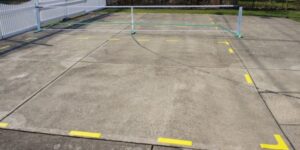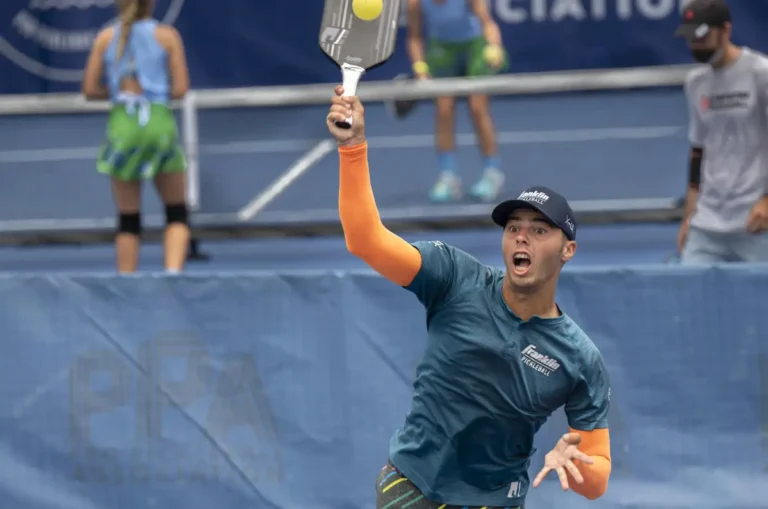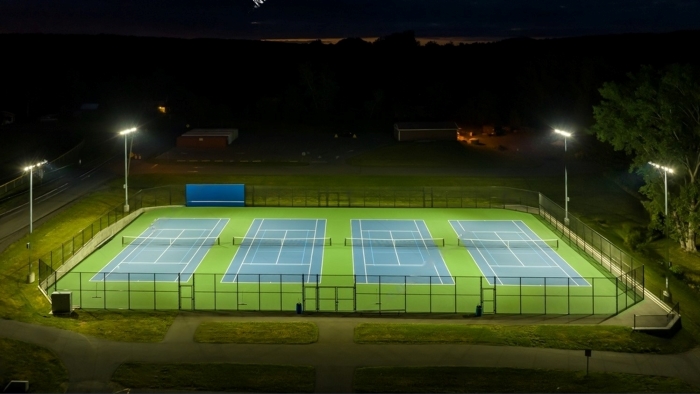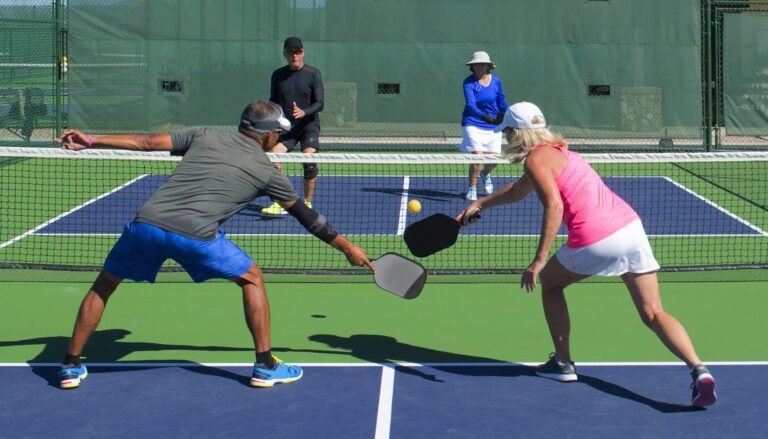How Much Does It Cost to Paint a Pickleball Court? Expert Guide
How Much Does It Cost to Paint a Pickleball Court? A Comprehensive Guide
The cost to paint a pickleball court ranges from $200 to $1,500, depending on factors like court size, surface condition, paint quality, and labor. DIY painting can save money but requires time and effort, while hiring professionals ensures quality results. Expect to pay $500 to $1,500 for professional painting of a standard pickleball court. Proper maintenance and timely repainting every 1-5 years can extend the life of your court and minimize long-term costs.
Key Takeaways
- The cost of painting a pickleball court can range from $200 to $1,500 or more, depending on various factors such as court size, surface condition, paint quality, and labor costs.
- Court size and dimensions, surface material and condition, paint quality and type, custom line colors, and labor costs are the main factors that influence the overall expense of painting a pickleball court.
- Hiring a professional contractor to paint your pickleball court will typically cost more than a DIY approach, but it can ensure a high-quality finish and long-lasting performance.
- DIY painting can save money on labor costs but requires time, effort, and attention to detail to achieve professional-looking results.
- To save money on your pickleball court painting project, consider obtaining multiple quotes from contractors, negotiating prices, and utilizing online resources and guides for DIY painting tips and techniques.
- Proper maintenance and timely repainting can extend the life of your pickleball court and minimize the need for frequent and costly repairs.
- Ultimately, the decision to paint your own pickleball court or hire a professional depends on your budget, skills, and available time and resources.
But have you ever wondered, “How much does it cost to paint a pickleball court?” In this comprehensive guide, we’ll break down the various factors that influence the cost of painting a pickleball court, helping you make an informed decision when it comes to creating or renovating your own court. See How Much It Cost to Build a Pickleball Court
Factors Affecting the Cost of Painting a Pickleball Court
Before we dive into the actual costs, let’s explore the main factors that can impact the overall expense of painting a pickleball court.
1. Court Size and Dimensions
The size of your pickleball court is one of the primary factors that will determine the cost of painting.
| Court Type | Dimensions | Total Playing Area |
|---|---|---|
| Standard | 20′ x 44′ | 880 sq. ft. |
| Doubles | 20′ x 64′ | 1,280 sq. ft. |
As you might expect, a larger court will require more paint and labor, which will ultimately increase the overall cost of the project.
2. Surface Material and Condition
The type of surface you’re working with can also significantly impact the cost of painting a pickleball court.
Common surfaces for pickleball courts:
- Concrete
- Asphalt
Concrete courts typically require less preparation work, as they are usually smoother and more level than asphalt surfaces. However, if your concrete court has cracks, chips, or uneven areas, you may need to invest in additional repairs before painting can begin.
Asphalt courts, on the other hand, often require more extensive preparation work. This may include:
- Filling cracks
- Leveling uneven areas
- Applying a sealant to create a smooth, even surface for painting
The condition of your court’s surface will also play a role in the overall cost of the project. A court with minimal damage and wear will require less preparation work and materials, while a heavily deteriorated surface may need significant repairs and resurfacing before painting can commence.
3. Paint Quality and Type
When it comes to painting a pickleball court, not all paints are created equal. The quality and type of paint you choose will not only affect the appearance of your court but also its durability and longevity.
For the best results, it’s recommended to use acrylic paint specifically designed for sports courts. These specialized paints are formulated to withstand the rigors of outdoor play, resisting fading, chipping, and peeling over time.
Higher-quality paints may come with a higher price tag, but they often provide superior coverage, durability, and color retention. Investing in a premium paint can save you money in the long run, as you’ll need to repaint less frequently.
4. Custom Line Colors
While the standard color for pickleball court lines is white, some players and court owners may opt for custom line colors to create a unique look or to match their branding. Choosing a non-standard color may slightly increase the cost of your painting project, as you may need to purchase additional paint colors or pay for custom color mixing.
5. Labor Costs
The cost of labor is another significant factor to consider when estimating the expense of painting a pickleball court. Labor costs can vary widely depending on your location, the complexity of the project, and whether you choose to hire a professional or tackle the painting yourself.
Professional Painting Costs
Hiring a professional contractor to paint your pickleball court will typically cost more than a DIY approach, but it can also provide peace of mind and ensure a high-quality finish. Professional painters have the experience, equipment, and expertise to properly prepare your court’s surface, apply the paint evenly, and create crisp, clean lines.
On average, professional pickleball court painting can cost anywhere from $500 to $1,500, depending on the size of your court, the condition of the surface, and your location. It’s essential to obtain quotes from multiple contractors to compare prices and find the best value for your budget.
DIY Painting Costs
For those looking to save money on their pickleball court painting project, a DIY approach may be an appealing option. By tackling the painting yourself, you can eliminate the cost of labor and have more control over the process.
However, it’s important to keep in mind that painting a pickleball court is a significant undertaking that requires time, effort, and attention to detail. You’ll need to purchase all the necessary materials, such as paint, rollers, brushes, and masking tape, which can add up quickly.
On average, the cost of materials for a DIY pickleball court painting project can range from $200 to $600, depending on the size of your court and the quality of the materials you choose. It’s always a good idea to purchase slightly more paint than you think you’ll need to account for any mishaps or touch-ups.
Breakdown of Pickleball Court Painting Costs
Now that we’ve explored the various factors that can impact the cost of painting a pickleball court, let’s break down the expenses in more detail.
Paint and Supplies
The cost of paint and supplies will depend on the size of your court, the quality of the materials you choose, and whether you’re hiring a professional or taking the DIY route.
Professional Painting
When hiring a professional contractor, the cost of paint and supplies is typically included in the overall project price. However, it’s always a good idea to clarify what materials are being used and ensure that they meet your expectations for quality and durability.
DIY Painting
For those tackling the painting project themselves, the cost of paint and supplies will be a significant portion of the overall expense.
| Item | Cost Range |
|---|---|
| Pickleball court paint | $200 – $600 |
| Additional supplies | $50 – $150 |
Remember, investing in higher-quality materials may cost more upfront but can provide better results and longer-lasting performance.
Labor
As mentioned earlier, labor costs can vary significantly depending on whether you choose to hire a professional or take on the project yourself.
Professional Painting
Professional pickleball court painting typically costs between $500 and $1,500, with the exact price depending on factors such as court size, surface condition, and location. When obtaining quotes from contractors, be sure to ask about their experience, the materials they use, and any warranties or guarantees they offer.
DIY Painting
By opting for a DIY approach, you can eliminate the cost of labor entirely. However, it’s essential to consider the time and effort required to complete the project. Painting a pickleball court can be a labor-intensive process, often taking several days to complete, depending on the size of your court and the condition of the surface.
If you’re considering a DIY painting project, be sure to factor in the cost of your time and energy, as well as any potential challenges or obstacles you may face along the way.
Saving Money on Painting Your Pickleball Court
While painting a pickleball court can be a significant investment, there are several ways to save money on the project without sacrificing quality or performance.
1. DIY vs. Hiring a Professional
One of the most obvious ways to save money on painting your pickleball court is to take on the project yourself. By eliminating the cost of labor, you can potentially save hundreds or even thousands of dollars, depending on the size and complexity of your court.
However, it’s important to weigh the pros and cons of a DIY approach before making a decision.
Pros of DIY painting:
- Potential cost savings
- More control over the process
Cons of DIY painting:
- Time-consuming and physically demanding
- Requires skill and attention to detail
- May not achieve professional-looking results
If you’re unsure about your ability to tackle the project yourself, or if you simply don’t have the time or energy to devote to the task, hiring a professional may be the better choice in the long run. A professional contractor can ensure that your court is properly prepared, painted, and finished, providing you with a high-quality playing surface that will last for years to come.
2. Obtaining Multiple Quotes
If you do decide to hire a professional to paint your pickleball court, one of the best ways to save money is to obtain quotes from multiple contractors. By comparing prices and services from several different providers, you can ensure that you’re getting the best value for your money.
When requesting quotes, be sure to provide each contractor with the same information about your court, including its size, surface material, and any specific requirements or preferences you may have. This will help ensure that you’re comparing apples to apples when reviewing the various quotes.
Don’t be afraid to negotiate with contractors or ask about any discounts or promotions they may be offering. Some providers may be willing to work with you to find a price that fits your budget, especially if you’re flexible on timing or willing to recommend their services to others.
3. DIY Painting Tips and Resources
For those who are determined to take on the challenge of painting their own pickleball court, there are several resources available to help guide you through the process.
Online Tutorials and Guides
There are numerous online tutorials, videos, and guides that provide step-by-step instructions for painting a pickleball court. These resources can be invaluable for those who are new to the process, offering tips and tricks for achieving professional-looking results.
Some popular resources include:
- The United States Pickleball Association (USAPA) website, which offers a wealth of information on court dimensions, line markings, and painting techniques.
- YouTube tutorials from experienced DIY enthusiasts and pickleball court contractors.
- Pickleball court painting kits, which include all the necessary materials and instructions for completing the project.
Proper Preparation and Technique
One of the keys to a successful DIY pickleball court painting project is proper preparation and technique. Before beginning the painting process, it’s essential to:
- Thoroughly clean and repair your court’s surface
- Fill any cracks or uneven areas
- Ensure that the surface is smooth and level
When applying paint, be sure to:
- Use even, consistent strokes
- Allow each coat to dry completely before applying the next
- Use masking tape or stencils to create crisp, clean lines
- Ensure that your court markings are accurate and uniform
By following these tips and techniques, you can achieve professional-looking results and save money on your pickleball court painting project.
Maintenance and Repainting
Once your pickleball court is painted, it’s important to maintain it properly to ensure its longevity and performance. The frequency of maintenance and repainting will depend on several factors, including:

- The quality of the paint and materials used
- The amount of use and wear the court receives
- The local climate and weather conditions
On average, a well-maintained pickleball court may need to be repainted every 1-5 years, depending on these factors. However, by taking proper care of your court and addressing any issues promptly, you can extend the life of your painted surface and minimize the need for frequent repainting.
Some signs that your pickleball court may need repainting include:
- Fading or discoloration of the painted surface
- Cracks, chips, or peeling paint
- Worn or faded line markings
- Uneven or slippery areas on the court surface
If you notice any of these issues, it’s important to address them promptly to prevent further damage and ensure the safety and playability of your court.
The cost of maintaining and repainting a pickleball court will depend on the same factors that influence the initial painting cost, including the size of the court, the condition of the surface, and whether you choose to hire a professional or do the work yourself.
Conclusion
In conclusion, the cost of painting a pickleball court can vary widely depending on a range of factors, including the size of the court, the condition of the surface, the quality of the materials used, and whether you choose to hire a professional or take on the project yourself.
On average, you can expect to pay anywhere from $200 to $1,500 or more to paint a pickleball court, with the exact cost depending on your specific circumstances and requirements.
When considering the cost of painting your pickleball court, it’s important to factor in not only the initial expense but also the long-term costs of maintenance and upkeep. By investing in high-quality materials and workmanship upfront, you can minimize the need for frequent repainting and ensure that your court remains safe, attractive, and playable for years to come.
Ultimately, the decision to paint your own pickleball court or hire a professional will depend on your budget, skills, and available time and resources. By carefully considering your options and weighing the pros and cons of each approach, you can make an informed decision that meets your needs and ensures the best possible results for your pickleball playing experience.
Frequently Asked Questions
Q: What is the best paint for a pickleball court?
A: For the best results, it’s recommended to use acrylic paint specifically designed for sports courts. These specialized paints are formulated to withstand the rigors of outdoor play, resisting fading, chipping, and peeling over time. Be sure to choose a high-quality paint from a reputable manufacturer for optimal performance and durability.
Q: How long do painted pickleball court lines last?
A: The longevity of painted pickleball court lines will depend on several factors, including the quality of the paint used, the amount of use the court receives, and the local climate and weather conditions. On average, painted court lines may last anywhere from 1-5 years before needing to be refreshed or repainted.
Q: Can I use regular paint for my pickleball court?
A: While it may be tempting to use regular paint for your pickleball court, it’s important to use specialized sports court paint for the best results. Regular paint is not formulated to withstand the harsh outdoor conditions and heavy use that a pickleball court is subjected to, and may quickly fade, chip, or peel. Investing in high-quality, specialized paint will ensure that your court looks and performs its best for years to come.
Q: How often should I repaint my pickleball court?
A: The frequency of repainting will depend on several factors, including the quality of the paint used, the amount of use the court receives, and the local climate and weather conditions. On average, a pickleball court may need to be repainted every 1-5 years to maintain its appearance and performance. However, by properly maintaining your court and addressing any issues promptly, you can extend the life of your painted surface and minimize the need for frequent repainting.




